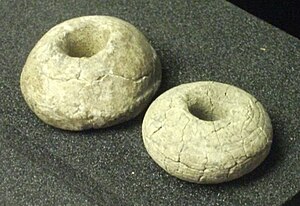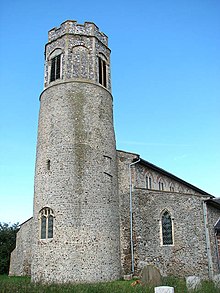Saxo-Norman

Saxo-Normanis the very end of theAnglo-Saxonperiod in England and the start of theNorman occupation,typically between 1060 and 1100. Often used to refer to architecture and physical culture, the term addresses the combination of Anglo-Saxon and Norman styles prevalent during the period.[1]
Architecture
[edit]In the years before the Conquest, various Saxo-Norman features emerged in English architecture, including "long and short" stonework, "half-roll" features on arches and double-splay windows.[2]After the Conquest, Saxo-Norman architecture was typically applied to smaller buildings, and small parts of larger projects.[3]Major ecclesiastical projects, such as cathedrals and abbey churches, were executed in a predominantlyNorman style.[4]AtExeter Castle,for example, Anglo-Saxon "long and short" stonework was used in the gatehouse, alongside arches common to both Norman and Anglo-Saxon styles, and some features borrowed from theHoly Roman Empire.[3]One of the reasons for this would have been the limited number of Norman craftsmen available for projects, and the continuity of local Anglo-Saxon preferences in many locations.[5]

Some Anglo-Saxon architectural features were never used under the Normans, and, as time went by, some Saxo-Norman features began to fade.[2]Old Anglo-Saxon features such as brick arches in stone buildings were simply eliminated from new designs, and "long and short" stonework, "half-roll" features slowly disappeared from use.[6]By the 12th century, parish churches were typically being built in a Norman, rather than Saxo-Norman style.[7]The fusion of surviving Anglo-Saxon elements into the Norman style eventually produced the EnglishRomanesquestyle of architecture.[8]
The phrase has been critiqued by historian John Gage as being "the architectural equivalent of a middle-aged spread".[9]
Physical culture
[edit]Saxo-Norman pottery began to be made in eastern England, including the towns ofStamfordandThetford,encouraged by contact from France and Scandinavia.[10]
References
[edit]- ^"Glossary",Pevsner Architectural Guides,retrieved27 November2013
- ^abFernie 2002,p. 211
- ^abFernie 2002,p. 20
- ^Fernie 2002,p. 208
- ^Fernie 2002,pp. 208–209
- ^Fernie 2002,pp. 208–211
- ^Fernie 2002,p. 39
- ^Fernie 2002,p. 318
- ^Fernie 1989,p. 24
- ^Mahany & Roffe 1983,p. 199
Bibliography
[edit]- Fernie, Eric (1989). "Archaeology and Iconography: Recent Developments in the Study of English Medieval Architecture".Architectural History.32:18–29.doi:10.2307/1568559.JSTOR1568559.
- Fernie, Eric (2002).The Architecture of Norman England.Oxford, UK: Oxford University Press.ISBN9780199250813.
- Mahany, Christine; Roffe, David (1983). "Thetford: The Development of an Anglo-Scandinavian Borough". In Brown, R. Allen (ed.).Anglo-Norman Studies: Proceedings of the Battle Conference 1982.Woodbridge, UK: Boydell Press. pp.197–219.ISBN9780851151786.

